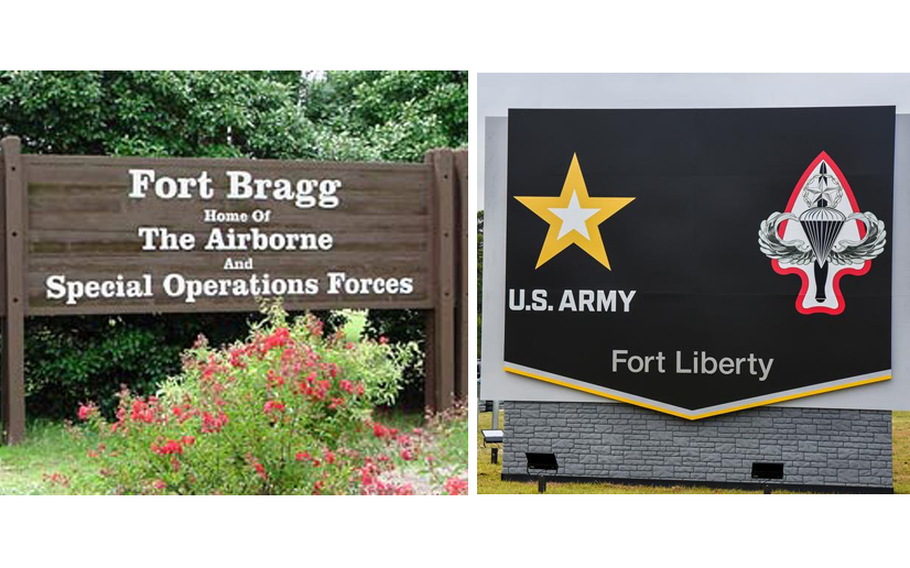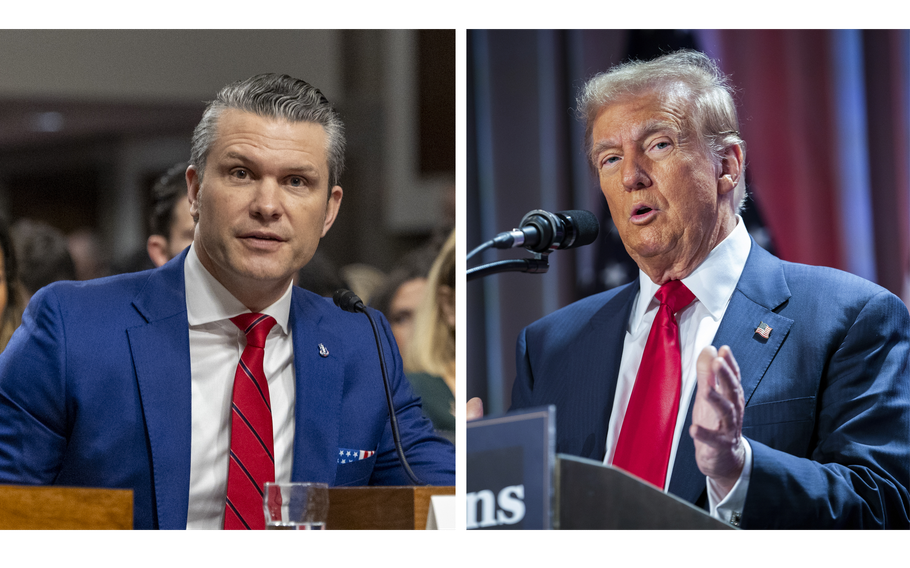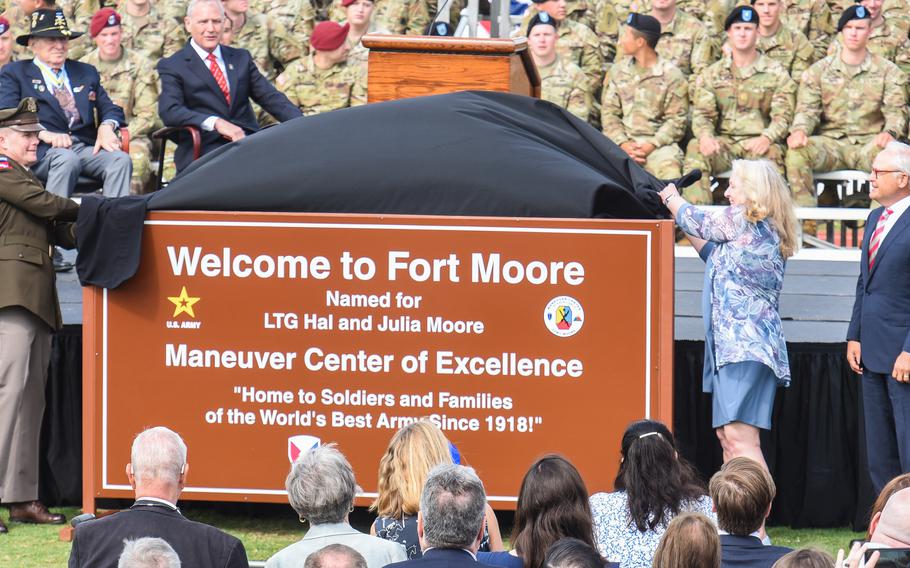
Long known as Fort Bragg, named for Confederate Gen. Braxton Bragg in 1918, the Army’s largest installation was changed to Fort Liberty in 2023 after a yearslong process mandated by Congress at the end of President-elect Donald Trump’s first term to rid the military of ties to the Confederacy. Trump promised on the campaign trail last year that he would reinstate Fort Bragg as the North Carolina Army post’s name and work to return Confederate-linked names to eight other southern Army bases changed in 2023. (Corey Dickstein/Stars and Stripes)
President-elect Donald Trump has made no attempt to hide his disdain for the name changes to nine southern Army installations in 2023, which grew out of a yearslong, multimillion-dollar effort that began in his first administration.
In October, at a Fayetteville, N.C., campaign event held less than 10 miles from the gates of the Army’s largest post, Fort Liberty, Trump promised a crowd of supporters that he would return the installation to its previous name — Fort Bragg. Until it was officially renamed Fort Liberty in a ceremony just off the 172,000-acre Army post’s main parade grounds on June 2, 2023, that base had carried the name of Confederate Gen. Braxton Bragg since its inception as a small artillery training post in 1918.
“Here’s what we do: We get elected [then] I’m doing it,” Trump told his supporters at the town hall event, drawing cheers and applause from the crowd. “I’m doing it. I’m doing it.”
“We did win two world wars from Fort Bragg, right? So, this is not a time to be changing names, and we’re going to do that. We’re going to do everything we can, and we’re going to get it back.”
Some of Trump’s supporters have long cheered his calls for Confederate names to remain on or return to Army posts, and some veterans who served at these installations have vowed to never recognize the official name changes that were conducted in ceremonies between March and October 2023, when Fort Pickett, Va., became Fort Barfoot; Fort Lee, Va., became Fort Gregg-Adams; Fort A.P. Hill, Va., became Fort Walker; Fort Hood, Texas, became Fort Cavazos; Fort Rucker, Ala., became Fort Novosel; Fort Polk, La., became Fort Johnson; Fort Bragg became Fort Liberty; Fort Benning, Ga., became Fort Moore; and Fort Gordon, Ga., became Fort Eisenhower.

Pete Hegseth, left, President-elect Donald Trump’s nominee for defense secretary, has joined the incoming president, right, in calls to return Fort Bragg and eight other southern Army bases to their previous Confederate-linked names. Current law bars a defense secretary or Army secretary from naming any military assets, including installations, for those who served as Confederate soldiers or leaders. (Eric Kayne/Stars and Stripes, Allison Robbert, Pool Photo via AP)
Trump’s choice for Defense Secretary, Pete Hegseth, a former Fox New host who served combat tours in Iraq and Afghanistan as an Army National Guard officer, is among those who have criticized the changes. In interviews, he has called the effort “a sham,” “garbage,” and urged officials to “change it back.”
Critics of Trump’s campaign promise to return Confederate-linked names to those bases said it would revert the military to honoring treasonous Confederate soldiers who killed American troops and undo a Congress-mandated process that cost taxpayers tens of millions of dollars. It would also strip honors from the Army leaders and war heroes for whom the installations — except for Fort Liberty — were renamed, said retired Army Brig. Gen. Ty Seidule, who served more than three decades as an armor officer and later as a professor and leader of the history department at the U.S. Military Academy at West Point, N.Y.
“Why wouldn’t we want to name it after the great heroes that we do have in the U.S. Army?” said Seidule, who served as the vice chairman of the Naming Commission, the bipartisan board created by Congress to identify Confederate associated items across the Defense Department inventory and recommend the changes ultimately implemented by the Pentagon. “They reflect the best of America. Inspirational people with inspirational stories.”
The new names include multiple Medal of Honor recipients for combat heroics ranging from the Civil War to the Vietnam War, trailblazing soldiers and other accomplished Army leaders.
As Trump returns to the White House on Monday, it is unclear precisely how the president-elect plans to undo the name changes, or whether he legally can revert those names back. Seidule and other members who served on the Naming Commission believe current law bans the Defense Department from naming any item in the military inventory, including its installations, for any person who served the Confederacy.
Bringing back Fort Bragg
The effort to remove Confederate names from the military, especially the southern Army posts named for Confederate officers in the 1910s and 1940s during the south’s Jim Crow era, began amid a nationwide racial reckoning after the Memorial Day 2020 killing of George Floyd by Minneapolis police. Pentagon leaders, including then-Army Secretary Ryan McCarthy and then-Defense Secretary Mark Esper, who had long opposed renaming installation names, signaled at the time that they were open to change. Congress included the effort in the 2021 National Defense Authorization Act — the annual must-pass bill that sets Congress’ policy and spending priorities for the Pentagon — creating the Naming Commission and encoding into law that the Pentagon rid its posts of Confederate names. Though Trump vetoed the bill, calling it an effort to “rewrite history” as a part of a “new left-wing cultural revolution,” Congress easily overrode his veto in a bipartisan New Year’s Day 2021 vote.
But about one year before Congress approved that controversial plan, a little-noticed amendment included in the 2020 NDAA effectively barred Pentagon officials from naming any military assets for anyone and anything associated with the Confederacy.
The language in the 2020 NDAA, which Trump signed into law in December 2019, entitled “Prohibition on names related to the Confederacy,” received little media attention at the time, but legal experts and Naming Commission members believe it ensures Congress would have to change the existing law to allow Trump to revert Army bases to their former, Confederate-linked names.
“In naming a new asset or renaming an existing asset, the secretary of defense or the secretary of a military department may not give a name to an asset that refers to, or includes a term referring to, the Confederate States of America… including any name referring to … a person who served or held leadership within the Confederacy; or a Confederate battlefield victory,” the 2020 NDAA reads. The legislation further defined assets as including “any base, installation, facility, aircraft, ship, equipment, or any other property owned or controlled by the Department of Defense or a military department.”
Despite the law, some officials conceded, Trump might attempt to make his promised changes via executive order. It was unclear Thursday whether Trump would include fulfilling that promise among his priorities on the first day of his second administration, as he plans to sign dozens of new orders, according to media reports. Trump’s transition team did not respond to multiple requests for comment on the issue.
A staffer for the Senate Armed Services Committee said the law was “somewhat ambiguous” given that it does not directly bar the president from renaming an installation.
“Typically, a president would issue an order like that to the defense secretary who would then order the service secretary to carry out the president’s order,” said the staffer, who spoke on condition of anonymity. “The law, written as it is, would not allow the [defense secretary] or the Army secretary to make that change.”
It is also unclear whether there is enough support in Congress for changing the names, even with Republicans controlling both chambers by slim majorities. Stars and Stripes sought comment from more than a dozen lawmakers — including those representing the installations impacted by the name changes and leaders for the Senate and House Armed Services committees – but received few responses on the issue.
One Republican, Rep. Don Bacon of Nebraska, said the issue was “fairly considered” in Congress and should be treated as settled law.
“Everyone had input on this — including President Trump,” said Bacon, a retired Air Force brigadier general and an Armed Services committee member. “The law is straightforward and speaks for itself: the Department of Defense will no longer honor officers of the Confederacy who betrayed their oaths and engaged in an armed rebellion against the United States and were defeated by naming important military bases after them.”
Instead, Bacon said U.S. military “bases should be named after heroes.”

Army Maj. Gen. Curtis Buzzard, the commander of the Maneuver Center of Excellence and Julie Moore Orlowski, Hal and Julia Moore’s daughter, unveil the new welcome sign for Fort Moore, Ga., during a ceremony May 11, 2023, to mark the change in name of the former Fort Benning. (Corey Dickstein/Stars and Stripes)
Costly, tedious process
Military officials have said the process to change the names of the nine Army posts and two Navy ships and to rename or remove thousands of other items across the Pentagon’s vast array of installations was tedious, time-consuming and expensive.
Officials at posts including Fort Liberty and Fort Moore told reporters that their staffs spent months inventorying every item on the post to ensure all remnants of the installations’ former names were removed, as the law prescribed.
The Army spent about $9.3 million just to rename its nine installations, according to a service spokesperson. That total does not include money spent on other related efforts, such as changing street, building and training range names.
The service spent about $342,000 for Fort Barfoot, $715,000 for Fort Novosel, $1.4 million for Fort Gregg-Adams, $2.2 million for Fort Cavazos, $825,000 for Fort Moore, more than $2 million for Fort Liberty, $265,000 for Fort Johnson, $352,000 for Fort Walker and more than $1 million for Fort Eisenhower, according to the Army. The costs were about 56% lower than the Naming Commission’s estimated costs, the spokesperson said.
The Pentagon money wasn’t the only taxpayer funding spent on the effort. States spent millions of dollars altering or posting new road signs reflecting the name changes. North Carolina spent about $450,000 to update 86 highway traffic signs from Fort Bragg to Fort Liberty, according to the North Carolina Department of Transportation.
Changing the names back would require a new funding authorization from Congress, the Senate staffer said. It could prove nearly as costly as the first renaming process and would render the past money spent to strip the Pentagon of Confederate honors “utterly wasted,” according to the staffer.
History vs. commemoration
Trump has often said the effort of removing Confederate base names disrespected the veterans who trained at those bases, especially those who died in battle.
His December 2020 statement announcing his veto of the 2021 NDAA said the bases had “taken on significance to the American story and those who have helped write it that far transcends their namesakes.”
Hegseth said removing the Confederate-linked names broke with a long tradition that links generations of soldiers who served at those posts. But the topic did not come up this week during his contentious confirmation hearing with the Senate Armed Services Committee.
“We should change it back. We should change it back,” Hegseth said on The Everyday Warrior Podcast in June 2024 before he was nominated for the top Pentagon post. “We should change it back because legacy matters. My uncle served at Bragg. I served at Bragg. It breaks a generational link.”
But Seidule, the Naming Commission vice chairman, rejects that argument. He said he tells detractors of the effort that they need to understand the difference between history and commemoration. Installation names, he said, do not reflect history but do serve as a commemoration.
“To commemorate is about our values, about what, who we think is representative and who we honor,” he said. “And so, when you know the full story of these people [the Confederate generals], you can’t honor them. And, now, their stories are out there about who they were and what they did.”
The Pentagon on Jan. 5, 2023, instructed all Defense Department organizations to begin working to remove names and items associated with the Confederacy as recommended by a congressional commission. This includes nine Army bases named for Confederate generals shown here. The bases were Fort Polk in Louisiana, Fort Benning and Fort Gordon in Georgia, Fort Bragg in North Carolina, Fort A.P. Hill, Fort Lee and Fort Pickett in Virginia, Fort Rucker in Alabama, and Fort Hood in Texas. Officials have said they would not recommend a name change for Camp Beauregard in Louisiana, which was also named for a Confederate general, because it is owned by that state’s National Guard. (Library of Congress)
Braxton Bragg is a good example, according to Seidule. Bragg graduated from West Point and served in the U.S. Army as an artillery officer for some 19 years before resigning his commission to purchase a sugar plantation in Louisiana, including more than 100 slaves. He took a commission as general in the Confederate Army after the Civil War began and ultimately earned a reputation for losing critical battles with poor military tactics and losing the respect of his men.
Some of the other Confederates who were previously honored with installation names never even served in the U.S. Army, including Henry Benning, Edward Rucker and John Gordon, Seidule said.
“The thing they did do was kill U.S. Army soldiers,” he said. “They committed treason for slavery and then they killed U.S. Army soldiers.”
Seidule argued that should be enough to convince any American patriot that Confederate names have no place on today’s Army posts.
“I hate people who killed U.S. Army soldiers,” he said he tells detractors of the name-changing efforts. “I wore U.S. Army blue for almost 36 years. I don’t like the enemy. … I love this country. I served in war and peace and to think that you’re going to honor someone that tried to destroy this country that we serve — terrible.”
The new names
Names now honored on installations include Lt. Gen. Hal and Julia Moore, the Distinguished Service Cross recipient for heroics in the first major battle of the Vietnam War and his wife who worked to improve the Pentagon’s casualty notice process and advocated for Army spouses and families. Others recognize Gen. Richard Cavazos, the Army’s first Hispanic general who was awarded the Medal of Honor for actions in the Korean War and the Distinguished Service Cross in Vietnam; Col. Charity Adams, the first Black female officer in the Women’s Army Auxiliary Corp; and Lt. Gen. Arthur Gregg, the service’s first Black three-star general, who enlisted initially in a segregated Army.
Fort Liberty’s name was chosen in honor of the bedrock American value, which was suggested by a North Carolina Gold Star mother, Patti Elliott, who told officials during the renaming process that her son, Army Spc. Daniel Lucas Elliott “died for liberty,” when he was killed in combat in Iraq in 2011.
The name-change effort even found support among at least some descendants of the Confederates that the base names previously honored. Denise Rucker Krepp said Wednesday it would be shameful if Confederate Col. Edward Rucker’s name was returned to the Army’s aviation training base in southern Alabama.
Krepp, a lawyer who works as a Navy civilian employee and former Coast Guard officer, had long sought to see her distant cousin’s name removed from the base. She said she avoided following her parents — both retired Army officers — into the service because she did not want to discuss her last name and its ties to the Confederacy. Krepp said her family is also distantly related to Benning.
When Fort Rucker became Fort Novosel — named for Vietnam War Medal of Honor recipient Chief Warrant Officer Michael Novosel — she was ecstatic because it finally meant Vietnam veterans such as her father were being recognized at such a high and visible level.
She said she would implore Trump not to restore her family’s name or those of the other Confederate leaders to U.S. installations. A reversion, she said, would anger her.
“My family committed treason. My family killed U.S. soldiers. My family owned human beings,” Krepp said. “Why are we recognizing people like this? I want to honor Vietnam veterans, and I’m getting really frustrated by the disrespect that’s being shown for them with this attempt to take their names off these bases.”
If Trump does move to strip the new names of the nine Army bases in favor of their former monikers, Krepp vowed to fight back.
Seidule coauthored a forthcoming book, “A Promise Delivered: Ten American Heroes and the Battle to Rename Our Nation’s Military Bases,” about the individuals whose names now adorn the renamed Army posts. He said if the base names are reversed it shows he and other historians have “a great deal more work to do.”
“I’m not going to cry in my cornflakes” if Trump undoes the Naming Commission’s work, Seidule said. “I’m going to continue to work as a historian and as an American to tell the story of our great heroes and also to tell the story of why we can’t go back to naming things after people who tried to destroy this great country.
“We have to commemorate out great heroes, not traitors who killed American soldiers.”